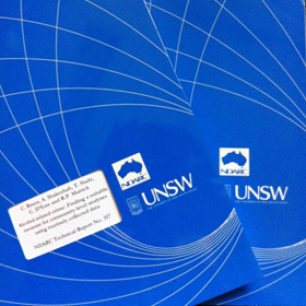NDARC Technical Report No. 298 (2008)
Summary
The State-Wide Advisory Team (SWAT): Drug Health Streamed Shared Care was established in 2005 by NSW Health and Drug Health Services, Sydney South West Area Health Service for the purpose of mapping, consulting and supporting opioid pharmacotherapy services across NSW. Specifically SWAT had the objective of building capacity within existing specialist and community facilities for the management of those with drug and alcohol problems, with an initial focus on those with opioid dependence.
To assist in the attainment of the goals of the SWAT project, it was decided to undertake a study to identify the range of work practices, clinical referral pathways and supporting policies currently in place in public clinics providing treatment for opioid dependence across NSW. In addition, the possible utility of benchmarks for staffing, capacity and service delivery was investigated. This report presents the findings of the Survey of NSW Opioid Treatment Program Public Clinics conducted by SWAT.
Initial consultations with Area Health Services (AHS) revealed wide variation in culture and priorities as well as in staffing levels, resources, and operational practices at public clinics across NSW. However, one of the few consistencies across the state was that many public clinics had a limited capacity to take on new-to-treatment clients and there appeared to be an under-utilisation of available community pharmacy dosing places.
Between April and September 2006 a questionnaire was sent to all public clinic Nursing Unit Managers (NUMs) across NSW. A response rate of 100% was achieved. Data was collected on a range of clinical and resource variables including staffing levels, client numbers, provision of takeaway doses, and the utilisation of community service providers such as community pharmacies and GP prescribers, and relationships with these service providers. Where appropriate, results have informed the development of recommendations for clinical practice and in some areas suggestions are made for benchmarking clinical activity and staffing to client ratios. Associated rationales and suggested ways of achieving these recommendations have also been developed. A full list of recommendations is provided in the report attached above.
Clinic characteristics
Thirty-five public clinics across NSW participated in the survey. The number of clinics in each AHS, as defined by the AHS, varied between one and seven. The majority were located on hospital grounds. Fourteen clinics reported having a private clinic in their local area (none of which were rural). All clinics except one provided both methadone (74% Methadone Syrup, 50% Biodone Forte, 24% both) and buprenorphine, with most not reporting either separate dosing times or areas. On average, 80% of those dosed at public clinics were on methadone. Forty-one percent of clinics (n=14) provided takeaways, of which eight clinics provided these at no charge.
All clinics provided case management and in all but three clinics this was delivered onsite. In terms of other on-site services, half the clinics reported providing other medications and approximately 40% providing services for other drug or alcohol problems. There was limited access to other on-site services, notably only 29% having a hepatology service, 23% a dental service, and 11% an on-site psychiatrist.
Client numbers, opening hours, clinic capacity
The mean number of clients managed at each clinic was 159 (range: 18-364). Only 21 clinics had a defined maximum capacity (with determinants including clients per full-time equivalent (FTE) case manager, FTE prescribers, number of medical session and dosing hours available).
In terms of opening hours, generally, the bigger the clinic the longer the opening hours. However, there was wide variation in dosing hours between clinics (two to eight hours/day) and there was generally very limited availability of early and late dosing. All but three clinics were open seven days a week. The majority of clients managed by a public clinic (59%) received their doses at a public clinic. The overall split between public clinic dosing and community dosing, however, varied widely between individual services. For example, the proportion of clinic-managed clients dosed at community pharmacies varied from 22% to 63% across the different AHS. The majority (80%) of clients managed by a public clinic had a public prescriber, regardless of where they were dosed (range: 57-100% across the AHS).
Staffing (nursing, medical, other) and clinical activity (including prescribing and case management)
Thirty-three clinics had a dedicated NUM position, and three-quarters had a dedicated administrative support position. The mean number of FTE clinical staff at each clinic was four. Just under half of the clinics reported having at least some non-nursing clinical staff. Taking into account case management activity, the mean number of clients per FTE case manager was 28 (range: 10-50). Ninety-four percent of clinics reported having on-site medical officers, with 54% having staff specialist medical cover. The mean number of four-hour medical sessions was 4.3 per week (range: 0.25-12). The mean number of clients seen per four-hour medical session varied between four and 25. Three-quarters of clinics reported having minimum periods for prescriber reviews, with only 50% setting this at three months or less.
Waiting lists
Nine clinics reported having a waiting list (although interpretation of this term was inconsistent). These findings should not be interpreted as meaning that the remaining clinics had available capacity. The findings only suggest that the majority of clinics do not keep a formal record of their inability to provide treatment to all those who present for treatment.
Shared care activities
The vast majority of clinics reported routine transfer of stable clients to pharmacies and 75% reported that they monitored available capacity within their local pharmacies. Two thirds of clinics reported the use of standard assessment tools for identifying stable clients for transfer. Less than half reported the transfer of stable clients to GPs and only two-thirds reported they had contact with any of their local GP divisions. Although many clinics recognised the utility of transferring patients to community providers, many AHS, particularly those located in rural areas, reported difficulty in accessing both GP prescribers and dosing community pharmacies.


